
The Via Sacra pilgrimage route presents itself to hikers in many different ways. The numerous sights and changing landscapes offer space for silence, to reflect on life and to harmonize the outer and the inner. I myself walked four stations and wrote about my experiences for the Protestant weekly newspaper "Der Sonntag".
Oybin: monks familiar with the scriptures and mossy rocks
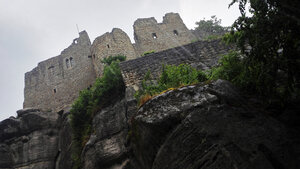
Mountains and high forest, an old castle ruin, a steam train, a cool footbath, cafés in a small spa town, peace and quiet. It's wonderful for me. I immediately confessed to the friendly man at reception, who greeted me by name when I arrived yesterday afternoon, that I had never been to the Zittau Mountains - even though I come from Leipzig. "You're not the only one, many Saxons think it ends after Bautzen," he said jokingly and to my astonishment.
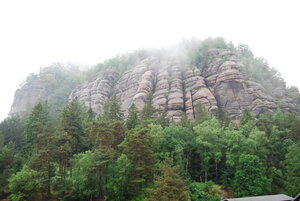
My hotel room had a direct view of the Oybin, i.e. the steep rock that supports the castle and monastery ruins and is somewhat reminiscent of the Orthodox Meteora monasteries in Greece. But unlike in Greece, the last monks of the former Celestine monastery have long since disappeared into the mists of history; the walls in which they studied ancient scriptures, prayed and sang in Latin are only a remnant - but in such an impressive way that they inspired renowned Romantic artists to create epoch-making works of poetry and painting in the 19th century.
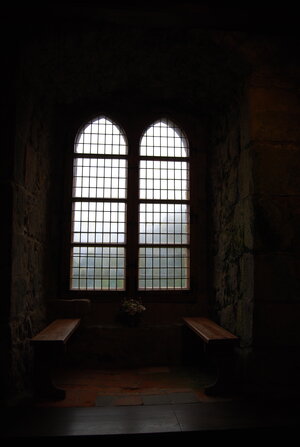
The fragmentary, Gothic window vaults of the once majestic building still make you feel the transience of earthly things today. Those who accept the invitation of silence can hear a hint of God's eternity. There is also a lot to tell about the castle part of the complex, which was built around 150 years earlier than the monastery. The compact tour took about an hour and a half, during which I and my fellow pilgrims were able to learn a lot of interesting facts about the origins and life of the castle: for example, that there were ultra-modern water pipes by the standards of the time, as well as a kind of underground parking garage and even underfloor heating based on an ancient model. The Zölestiner monks, who were extremely knowledgeable about history and writing, installed this - or rather, presumably had it installed - when their monastery next door was still being built and they were housed in the castle complex in the meantime. The heating system was also improved during operation and the engineering technology was fine-tuned, as we learn from Bruni, our tour guide. Amazingly, even today, new things are constantly being discovered about the history of the castle and the monastery, giving us the feeling that it has never really ceased to be inhabited.
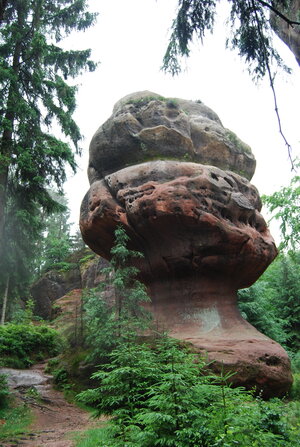
From Oybin in the direction of Zittau, we first head south past the so-called Kelchstein, a 17-metre-high mushroom-like sandstone. In general, the route to Zittau is characterized by rugged rocks and moss-covered stones - and a sometimes astonishing ascent and descent, which those in poor physical condition should not underestimate. However, the magnificent views from some of the vantage points are a reward in good weather. After almost 30 degrees the day before, I was glad that it was drizzling and cooler, and I didn't mind the fog either.
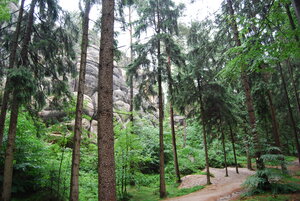
It's good, especially on difficult hiking sections, if you're not alone but in a group like us: this makes the strenuous stretches easier and you can hold hands if necessary. There was a very nice and equally welcome lunch break at the "Töpfer", then we headed downhill to the Teufelsmühle.
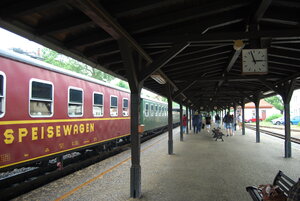
We were delighted when the steam train came whizzing around the corner and we were even able to board the "Mitropa". And so we went to Zittau. Alternatively, you can travel the whole route from Oybin to Zittau on the narrow-gauge railroad, but it is advisable to check the seasonal timetables beforehand. After a short break at our accommodation, we visited the Fastentücher, the second stop on the Via Sacra.
Zittau - the city of Lenten cloths
In Zittau, the Great Zittau Lenten Shroud from 1472 and the Small Zittau Lenten Shroud from 1573 are on display in the Church of the Holy Cross Museum.

Such "Lenten cloths" were once traditionally hung in churches to cover the crucifix or the entire chancel in the run-up to Easter. The purpose: to obscure the view of the Blessed Sacrament for believing Christians so that they could reflect even more inwardly during Lent on what they had been given by God through Jesus Christ, his voluntary substitutionary sacrificial death and resurrection. The website of the town of Zittau states: "These cloths were known as hunger cloths or pining cloths because they prevented the faithful who were 'starving' or 'pining' for the Eucharist from seeing the Blessed Sacrament". The Eucharist refers to the Lord's Supper, which for 2,000 years has been used in church services to commemorate the meal Jesus shared with his disciples immediately before his suffering and death and in which believers take part by partaking of consecrated hosts and wine.

While the small Zittau Lenten cloth shows the crucifixion of Jesus, the 56 square meter large cloth is a picture story with captions in Middle High German. "In addition to a surrounding painted frame, it shows 90 individual panels with scenes from the biblical story," says "Die Zittauer Bibel", published by Friedhelm Mennekes. "The special feature of the Great Lenten Veil is the unity of word and image," say the authors. This is because the captions to the 90 pictures consist of 45 double verses with end rhymes. "On closer inspection, this Lenten cloth proves to be a masterpiece of didactic preparation of biblical knowledge of faith." The cloth was donated by Zittau spice and grain merchant Jacob Gürtler. It was originally housed in St. John's Church in Zittau.
Twice in history, the cloth was considered lost, but was found again after the Second World War, having been badly damaged. In the meantime, it was used as a tarpaulin for a Russian sauna, we learn during the museum tour with museum director Dr. Peter Knüvener, while we throw our hands over our heads. An attempt at restoration was made in the 1970s, but was abandoned. It was finally professionally conserved between 1994 and 1995. The best way to find out more about the cloth's eventful history is to take a guided tour.
The foreword to "The Zittau Bible" states: "The centuries-long existence of such rare cultural assets as the Zittau Lenten cloths cannot be taken for granted. It is due to the commitment of individual people at decisive moments, when they were there to remind, save or support. That is why the Great Shroud in particular is a reminder of the people of Zittau. Its creation, rescue, preservation and restoration are due to their often courageous, sometimes stubborn and sometimes stubborn commitment, but always imaginative dedication."

Although the Lenten cloth hangs in a church again today - even if it is now a museum - it is mostly in the dark for its own protection. It no longer serves its original purpose. But it can still be viewed and admired. Its miraculous preservation today not only refers to the sometimes painful history of God with mankind, as can be seen in the illustrations; rather, the great care and faithfulness of individual people for this history of salvation that has become cloth is now also woven into the fabric in return. This truly makes it something special.
From Zittau to St. Marienthal
Today, after a delicious breakfast, we continue on to Ostritz, more precisely to the Cistercian monastery of St. Marienthal. We cover a total of 20 kilometers in glorious hiking weather on this day. The Via Sacra on this section of the trail runs along barley fields, through a romantic, high grassy avenue and through tranquil villages that seem rather deserted.

A few kilometers before Hirschfelde, we pass the traces of the former forced labour camp "Seiferts Höhe". Memorial plaques on the remaining buildings and sparse foundation walls remind us of the suffering and injustice inflicted on prisoners from various countries here. Fortunately, this chapter is over. Today there are a few allotment gardens in the immediate vicinity; a power station on the Polish side dominates the background of the scenery.
This part of the route reminds me that I have every reason to be grateful - even that there is still war and persecution in other parts of the world today. I ask myself: what can I do in my own life to help change this? Where am I asked not to close my eyes? These questions are also on the path of the "holy road".
We walk along the rather turbulent Neisse for a while, then head into the forest again, uphill. The last section of the path is a bit of a drag, I think, but it works. The intermittent rain is refreshing. Partly barefoot and exhausted, we finally arrive at St. Marienthal Monastery. Cistercian nuns have lived, prayed and worked here without interruption since 1234, even through the Reformation and the GDR era.

As soon as we arrive, we are given a detailed tour by Dr. Michael Schlitt, the director of the "Internationales Begegnungszentrum St. Marienthal" (IBZ) foundation, which has been closely associated with the monastery since shortly after the fall of the Berlin Wall. The nuns themselves are represented on the foundation's board and executive committee. Among other things, the IBZ runs the monastery's four guest houses, where pilgrims and those seeking relaxation can stay in various price categories. The foundation also offers a strong political, social and ecological education program for different target groups. The forest adventure trail, the show apiary and the orchard, for example, are part of the affiliated nature conservation station.

For the past eight years, the IBZ has offered the opportunity to complete a "Voluntary Political Year" in the field of political youth education. As a counterweight to right-wing extremist events in the area, the IBZ has successfully launched the "Ostritzer Friedensfest" event series. In June 2021, the foundation was awarded the fourth Catholic Prize against Xenophobia and Racism by the German Bishops' Conference, reports the director.

Visitors to the monastery can find peace and quiet in the church, attend services and join in the sisters' prayer times. In addition to the church, abbey buildings and guest houses, the convent has "the easternmost vineyard in Germany", as Michael Schlitt says, a whole series of farm buildings and a garden of biblical plants. After a wonderful dinner, I can look out of my window in the St. Hedwig guest house before falling into bed and deep dreams. It's a shame that I have to move on tomorrow...
Görlitz: The little Jerusalem
My night was wonderful, surrounded by the convent walls. Before breakfast, I go to the church for a short while and witness the end of mass and the sisters' prayer time afterwards. After a welcome breakfast, I continue on to Görlitz. I confess: for me it's the bus today, even though the walking or cycling route is worthwhile and most of our group opt for the bike.

The bus stop is a few hundred meters above the monastery. As I look around and see the monastery buildings once again, I think it's a shame not to stay longer. But you can always come back.
The journey takes about half an hour. This is where we part ways; we say goodbye and somehow I already miss my fellow pilgrims as I head for the nearest café on my own to plan my route in peace. That's also part of a pilgrimage: suddenly being alone again after being part of a community.
The first place I visit is the Evangelical City Church of St. Peter and Paul. It is probably the oldest church in the city, having emerged from an early castle church from the 11th century, as can be read on the Görlitz city website. In 1423, during the Gothic period, it was rebuilt into a mighty five-aisled hall church and decorated with towers. It is the largest and oldest church of its kind in Saxony and served as a model for many later buildings.

It is home to the sun organ. It was completed in 1703 - by none other than the then highly renowned imperial court organ builder Eugenio Casparini, who signed the contract for its construction in 1697 and now, at the age of 73, turned his back on the Viennese court. His son was also involved in the construction. Casparini originally came from Upper Lusatia and was actually called Johann Eugen Caspar. However, as he went to Italy in his youth and worked there for several decades, he changed his name accordingly, which did not harm his career. Today, the organ has over 88 stops with 6,095 sounding pipes. The façade - the visible front part of the organ - features 17 "suns", whose rays are small pipes. Today, Ms. Sun plays the organ and lets its special sound come to the fore. A special feature: the so-called Onda maris stop (Italian for sea wave) is tuned a millimetre lower than normal, which, in combination with other stops, produces a wave-like, ethereal sound that is said to characterize the transubstantiation of bread and wine during the Eucharist. This and much more is explained to the visitors during the organ presentation by Ruth-Andrea-Lammert (Freundeskreis Görlitzer Sonnenorgel eV) and immediately demonstrated in sound by Ms. Sun.

Time is moving fast, I will hurry straight to the Holy Sepulchre. This is as much a part of St. Peter's Church as the Way of the Cross, which inconspicuously connects the church and the tomb. The Holy Sepulchre is a replica of the most central parts of the great Church of the Holy Sepulchre in Jerusalem, the site of the crucifixion, burial and resurrection of Jesus Christ, 2,717 kilometers to the south-east. The small copy in Görlitz consists of a double chapel on two floors, the anointing house and the burial chapel. It is thanks to the piety of Georg Emmerich from Görlitz, who began building it after returning from his pilgrimage to Jerusalem in 1465. It was completed in 1504 - 13 years before theology professor and church reformer Dr. Martin Luther was to go public with his theses in Wittenberg. The Holy Sepulchre is considered an "impressive testimony to late medieval piety" (Evangelische Kulturstiftung Görlitz).
Unfortunately, my train is leaving soon and my pilgrimage is coming to an end. I very much believe and hope that I have not been here for the last time.




